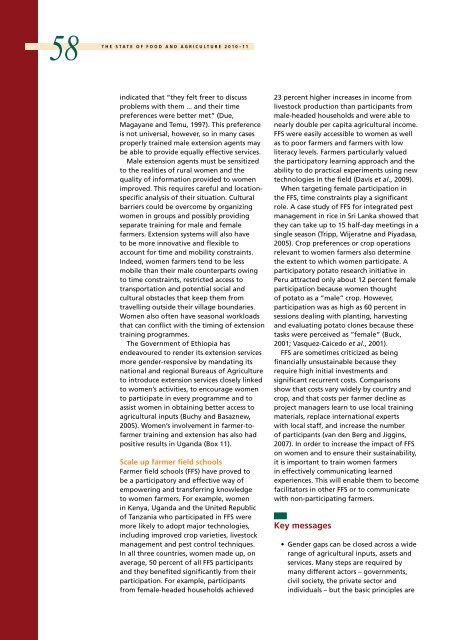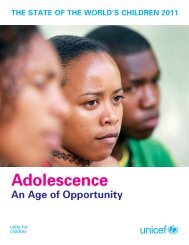The State of Food and Agriculture 2010-11: Women in ... - FAO
The State of Food and Agriculture 2010-11: Women in ... - FAO
The State of Food and Agriculture 2010-11: Women in ... - FAO
You also want an ePaper? Increase the reach of your titles
YUMPU automatically turns print PDFs into web optimized ePapers that Google loves.
58<br />
T H E S t a t E O F F O O D A N D A G R I C U L T U R E 2 0 1 0 – 1 1<br />
<strong>in</strong>dicated that “they felt freer to discuss<br />
problems with them ... <strong>and</strong> their time<br />
preferences were better met” (Due,<br />
Magayane <strong>and</strong> Temu, 1997). This preference<br />
is not universal, however, so <strong>in</strong> many cases<br />
properly tra<strong>in</strong>ed male extension agents may<br />
be able to provide equally effective services.<br />
Male extension agents must be sensitized<br />
to the realities <strong>of</strong> rural women <strong>and</strong> the<br />
quality <strong>of</strong> <strong>in</strong>formation provided to women<br />
improved. This requires careful <strong>and</strong> locationspecific<br />
analysis <strong>of</strong> their situation. Cultural<br />
barriers could be overcome by organiz<strong>in</strong>g<br />
women <strong>in</strong> groups <strong>and</strong> possibly provid<strong>in</strong>g<br />
separate tra<strong>in</strong><strong>in</strong>g for male <strong>and</strong> female<br />
farmers. Extension systems will also have<br />
to be more <strong>in</strong>novative <strong>and</strong> flexible to<br />
account for time <strong>and</strong> mobility constra<strong>in</strong>ts.<br />
Indeed, women farmers tend to be less<br />
mobile than their male counterparts ow<strong>in</strong>g<br />
to time constra<strong>in</strong>ts, restricted access to<br />
transportation <strong>and</strong> potential social <strong>and</strong><br />
cultural obstacles that keep them from<br />
travell<strong>in</strong>g outside their village boundaries.<br />
<strong>Women</strong> also <strong>of</strong>ten have seasonal workloads<br />
that can conflict with the tim<strong>in</strong>g <strong>of</strong> extension<br />
tra<strong>in</strong><strong>in</strong>g programmes.<br />
<strong>The</strong> Government <strong>of</strong> Ethiopia has<br />
endeavoured to render its extension services<br />
more gender-responsive by m<strong>and</strong>at<strong>in</strong>g its<br />
national <strong>and</strong> regional Bureaus <strong>of</strong> <strong>Agriculture</strong><br />
to <strong>in</strong>troduce extension services closely l<strong>in</strong>ked<br />
to women’s activities, to encourage women<br />
to participate <strong>in</strong> every programme <strong>and</strong> to<br />
assist women <strong>in</strong> obta<strong>in</strong><strong>in</strong>g better access to<br />
agricultural <strong>in</strong>puts (Buchy <strong>and</strong> Basaznew,<br />
2005). <strong>Women</strong>’s <strong>in</strong>volvement <strong>in</strong> farmer-t<strong>of</strong>armer<br />
tra<strong>in</strong><strong>in</strong>g <strong>and</strong> extension has also had<br />
positive results <strong>in</strong> Ug<strong>and</strong>a (Box <strong>11</strong>).<br />
Scale up farmer field schools<br />
Farmer field schools (FFS) have proved to<br />
be a participatory <strong>and</strong> effective way <strong>of</strong><br />
empower<strong>in</strong>g <strong>and</strong> transferr<strong>in</strong>g knowledge<br />
to women farmers. For example, women<br />
<strong>in</strong> Kenya, Ug<strong>and</strong>a <strong>and</strong> the United Republic<br />
<strong>of</strong> Tanzania who participated <strong>in</strong> FFS were<br />
more likely to adopt major technologies,<br />
<strong>in</strong>clud<strong>in</strong>g improved crop varieties, livestock<br />
management <strong>and</strong> pest control techniques.<br />
In all three countries, women made up, on<br />
average, 50 percent <strong>of</strong> all FFS participants<br />
<strong>and</strong> they benefited significantly from their<br />
participation. For example, participants<br />
from female-headed households achieved<br />
23 percent higher <strong>in</strong>creases <strong>in</strong> <strong>in</strong>come from<br />
livestock production than participants from<br />
male-headed households <strong>and</strong> were able to<br />
nearly double per capita agricultural <strong>in</strong>come.<br />
FFS were easily accessible to women as well<br />
as to poor farmers <strong>and</strong> farmers with low<br />
literacy levels. Farmers particularly valued<br />
the participatory learn<strong>in</strong>g approach <strong>and</strong> the<br />
ability to do practical experiments us<strong>in</strong>g new<br />
technologies <strong>in</strong> the field (Davis et al., 2009).<br />
When target<strong>in</strong>g female participation <strong>in</strong><br />
the FFS, time constra<strong>in</strong>ts play a significant<br />
role. A case study <strong>of</strong> FFS for <strong>in</strong>tegrated pest<br />
management <strong>in</strong> rice <strong>in</strong> Sri Lanka showed that<br />
they can take up to 15 half-day meet<strong>in</strong>gs <strong>in</strong> a<br />
s<strong>in</strong>gle season (Tripp, Wijeratne <strong>and</strong> Piyadasa,<br />
2005). Crop preferences or crop operations<br />
relevant to women farmers also determ<strong>in</strong>e<br />
the extent to which women participate. A<br />
participatory potato research <strong>in</strong>itiative <strong>in</strong><br />
Peru attracted only about 12 percent female<br />
participation because women thought<br />
<strong>of</strong> potato as a “male” crop. However,<br />
participation was as high as 60 percent <strong>in</strong><br />
sessions deal<strong>in</strong>g with plant<strong>in</strong>g, harvest<strong>in</strong>g<br />
<strong>and</strong> evaluat<strong>in</strong>g potato clones because these<br />
tasks were perceived as “female” (Buck,<br />
2001; Vasquez-Caicedo et al., 2001).<br />
FFS are sometimes criticized as be<strong>in</strong>g<br />
f<strong>in</strong>ancially unsusta<strong>in</strong>able because they<br />
require high <strong>in</strong>itial <strong>in</strong>vestments <strong>and</strong><br />
significant recurrent costs. Comparisons<br />
show that costs vary widely by country <strong>and</strong><br />
crop, <strong>and</strong> that costs per farmer decl<strong>in</strong>e as<br />
project managers learn to use local tra<strong>in</strong><strong>in</strong>g<br />
materials, replace <strong>in</strong>ternational experts<br />
with local staff, <strong>and</strong> <strong>in</strong>crease the number<br />
<strong>of</strong> participants (van den Berg <strong>and</strong> Jigg<strong>in</strong>s,<br />
2007). In order to <strong>in</strong>crease the impact <strong>of</strong> FFS<br />
on women <strong>and</strong> to ensure their susta<strong>in</strong>ability,<br />
it is important to tra<strong>in</strong> women farmers<br />
<strong>in</strong> effectively communicat<strong>in</strong>g learned<br />
experiences. This will enable them to become<br />
facilitators <strong>in</strong> other FFS or to communicate<br />
with non-participat<strong>in</strong>g farmers.<br />
Key messages<br />
• Gender gaps can be closed across a wide<br />
range <strong>of</strong> agricultural <strong>in</strong>puts, assets <strong>and</strong><br />
services. Many steps are required by<br />
many different actors – governments,<br />
civil society, the private sector <strong>and</strong><br />
<strong>in</strong>dividuals – but the basic pr<strong>in</strong>ciples are
















